Features of home sewage
Sewerage is an integral part of the water disposal and water supply system. It is designed to remove liquid and solid products of human vital activity, to purify household water from pollution and return them for further use or to a reservoir. The sewerage system is necessary for comfortable living in a house or apartment.
Residents of apartment buildings are responsible for the condition of the sewer pipes in the apartment, and the owners of private properties must independently arrange local treatment facilities, remove sewage and maintain pipelines and equipment.
In order to avoid unpleasant problems in the future, the requirements of the SNiP regulatory documents for water disposal and sewerage should be observed. Then the system will work normally, without requiring constant monitoring or adjustment.
 Having a properly designed and installed sewerage system will make life more comfortable, help maintain the ecological balance on the site and extend the life of buildings.
Having a properly designed and installed sewerage system will make life more comfortable, help maintain the ecological balance on the site and extend the life of buildings.
The structure of internal sewer networks includes:
- plumbing fixtures with water drainage;
- a common riser to which sewer pipes are connected;
- piping, which ensures the process of transporting wastewater from the drain to the riser.
Requirements for internal networks are specified in SNiP “Internal Sewerage”, in GOST and SNiP “Sewerage”.The systems are mounted inside the building and ensure the transportation of all drains from the place of their formation to the outlet of the pipe from the building.
Basic requirements for internal networks:
- When installing plumbing on drains, a water seal is required.
- For laying networks, cast-iron or plastic pipes are used.
- The diameter of the outlet of the sewer system from the house is at least 110 mm.
- When laying pipes, a slope of 2 to 2.5% must be maintained.
The internal networks of the sewer system must be equipped with ventilation. The process of ventilation of networks is carried out through common sewer risers - an exhaust part is installed, which is displayed on the roof.
 The main reason for clogging of sewer pipes in the bathroom is a significant accumulation of fat and other deposits on the inner surface of the pipe.
The main reason for clogging of sewer pipes in the bathroom is a significant accumulation of fat and other deposits on the inner surface of the pipe.
Due to the resulting blockages, the normal drainage of wastewater becomes impossible, therefore, it is necessary to immediately resume the full functioning of the sewer system. In order to avoid unpleasant consequences due to a blockage in the pipeline, you need to call specialists or clean the sewer yourself.
Causes of blockages
"Plugs" in the pipes can form for various reasons. Most often they occur due to clogging of the sewer with foreign objects.
This can happen if food waste, cat litter, rags, plastic bags, feminine hygiene items are thrown into the toilet.
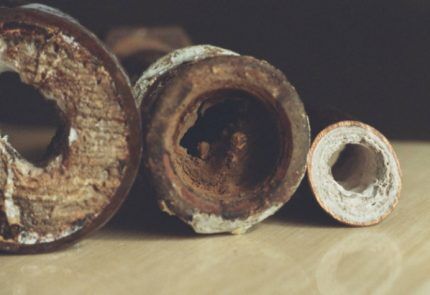 Deposits of urinary stone, lime, hardened dirt or other substances often cause partial or complete blockage of sewer pipes.
Deposits of urinary stone, lime, hardened dirt or other substances often cause partial or complete blockage of sewer pipes.
The lack of proper plumbing care negatively affects the pipes. Without regular cleaning of the system, urinary stone growths can form inside, which can narrow or even block the drain. Blockage can also be caused by salt deposits, which is typical for areas where hard water circulates in the plumbing system.
How can a toilet become clogged if it is installed incorrectly?
With improper design or when using pipes that do not match the diameter or are made of a material that does not have the necessary qualities to install them in the sewer system, it will not work to fix the problem easily and quickly.
- Violation of technology can lead to sagging pipes. As a result of this, stagnation of water appears in them along with waste, which will inevitably lead to dense blockages.
- In an autonomous sewer system of a private house, pipes that are not deep enough into the ground can freeze, which leads to damage - the plastic becomes brittle and can crack. In this case, soil can enter the pipe and block the discharge of water and waste. The consequences are obvious - a strong blockage, which, moreover, will be very difficult to find and eliminate.
- An unacceptably large number of pipe turns at right angles is a common cause of obstruction in the areas where bends are installed.
To get rid of frequently recurring emergencies with an improperly installed sewerage system, you will have to solve the problem radically.That is, replace pipes or lay them in a different, correct pattern. Otherwise, such problems cannot be avoided - they will arise again and again.
What requirements should a properly organized sewerage meet?
We have to admit that often the owners of houses, trying to save on materials and labor costs, violate the installation rules, simplify the schemes, and use components that are not designed for real operating conditions. All this usually ends sadly. In order, in principle, to prevent the prerequisites for accidents, when installing a sewer with your own hands, you should strictly follow the established rules. All this is described in great detail in a special publication of our portal.
What should not be flushed down the toilet?
Another question that often arises when blockages occur is whether they can appear from a tampon or toilet paper thrown into the toilet? Therefore, it must be clarified that nothing should be thrown into the central sewer, except for toilet paper, which decomposes in water. If the question concerns an autonomous system, then even toilet paper is not recommended to be lowered into it, since if it lingers in the pipes, then clogging cannot be avoided over time.
Fat that gets into the toilet can provoke a hard-to-remove plug.
You can not drain the fat formed in the pans during cooking into the toilet. They should be cleaned with a paper towel, which must then be thrown into the trash.
Another worst enemy of sewers is tea leaves, which act worse than cement, taking away pipes, especially if small deposits have already formed on their walls.
Never flushed into the toilet and construction dust, which is also capable of forming a plug inside the system.
Leftover food is also not recommended to be sent to the sewer, unless it is equipped with a special waste grinder. They can get stuck in the turns of the pipes and provoke their obstruction.
Determining the type and location of blockage in the system
Before you take action to clean the plumbing device, you need to determine the type of congestion, and also, if possible, find out where it is located. To do this, you need to carry out a few simple manipulations.
First of all, you need to find out whether water enters the sewer or the system is completely blocked. To do this, it is enough to pour about a liter of liquid into the toilet bowl, and after 30 minutes check its presence.
It is undesirable to use water from a flush tank for this, since in this case a large volume will be poured into the bowl - 3 liters or more.
Even the slow seepage of water into the drain indicates that we are talking about a fairly light blockage, which in most cases you can deal with yourself.If the fluid does not pass at all, a more serious problem is possible.
- The first sign of a blockage in the toilet is poorly draining water, which slowly drains into the sewer after 2-3 “idle” flushes. Similar emergencies that you can deal with on your own occur with both floor and wall-mounted toilets. But those who want to clean it themselves need to know the design of the device well.
- The second sign that you should pay close attention to is an unpleasant odor.Such a situation as in the photo may not yet exist, but stagnation and “aromas” are already accumulating, forming the prerequisites for the appearance of a traffic jam. When the first and second signs are detected, it is enough to influence the blockage with chemical household products that can dissolve organic sediment.
- If an object of inorganic origin, for example, a children's toy, gets into the toilet, it is useless to dissolve it, it is better to get it manually or using a plunger.
- A serious blockage that is not amenable to chemical methods and vacuum action with a plunger is punched with a plumbing cable. Breaking a jam with a pressurized water jet is an effective method, but only available if the appropriate equipment is available.
- If the plug clogged the outlet into the sewer, and it is impossible to remove it using the above methods, you will have to disassemble the toilet connection with the sewer, remove the blockage and collect everything back.
Primary and preventive measures:
- Impact on the cork in the toilet with a plunger.
- Punching a blockage with a plumbing cable.
- Hydraulic plug removal technology.
- Dismantling the connection of the toilet bowl with the release into the sewer
In this case, you need to check if there is a blockage in the local or central sewer system. To do this, you need to open the taps of the rest of the plumbing devices and see how the water drains.
If the liquid comes out as usual, then the blockage is most likely in the pipe at the outlet of the toilet.With a weak flow in all appliances, the problem may be in the general house sewer system.
The situation requires special attention if the waste floats in the drain devices of the bathroom or sink.It is worth asking the neighbors about the state of their plumbing - this problem may affect the premises located along the riser.
In case of a positive answer, it is better to immediately call professional plumbers: most likely the “cork” is located outside a certain apartment.
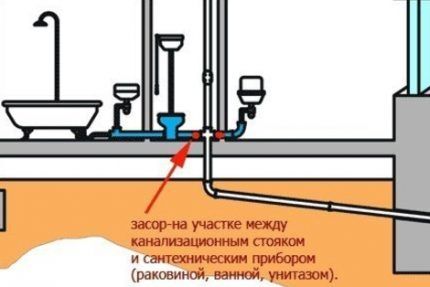
If the neighbors' sewer works normally, then the blockage is in the bend of the pipe leading to the toilet or in the lounger of the apartment wiring. This is a rather serious situation, but you can try to resolve it yourself.
In almost all cases, blockages do not occur on flat sections of pipes, but at joints, bends and transitions. It is these places that should be examined first of all, trying to find a “plug” in the sewer.
How to pump out water?
If the sewer is clogged tightly, then the water drained from the tank will remain in the bowl. To start cleaning work, it should be scooped out.
It is convenient to scoop out water with an empty plastic bottle of shampoo or dish detergent:
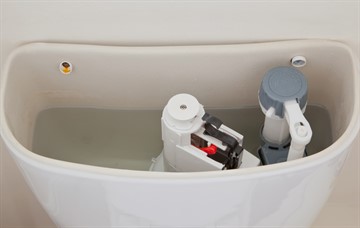
- the vial is turned upside down and squeezed;
- immerse the neck in water and stop squeezing the container: in this case, it will regain its previous shape, and a portion of the water will be drawn in;
- place the vial over the bucket and empty it by squeezing.
This method allows you to remove water even from the siphon.
Blockage Removal Methods
If the drain clogs unexpectedly, many home craftsmen prefer to act quickly when it comes to deciding what to do when the toilet is clogged, and immediately take appropriate action.
Sometimes, when the case is simple, because it is caused by a small amount of deposits accumulated on the pipes, folk methods that have already been used many times in practice will help.
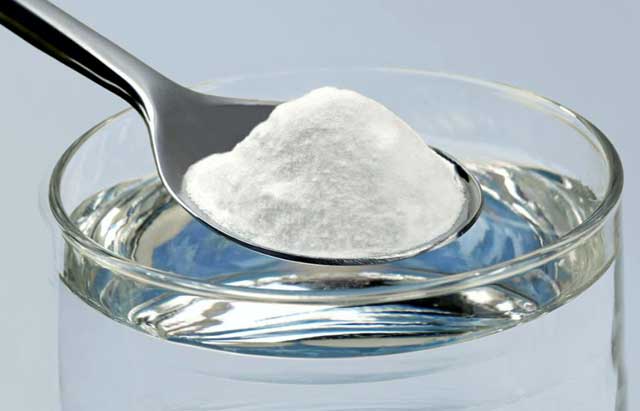
The problem associated with the fact that the toilet is clogged and how to clean it immediately can be solved by applying:
- boiling water;
- baking soda;
- boiling water plus soda plus vinegar;
- mustard.
There is a quick option on how to clean the blockage in the toilet with boiling water, for which:
- First prepare a bucket of boiled water.
- Then its contents are poured into the device, holding the container at a right angle and performing actions as quickly as possible.
- When the liquid leaves slowly, the process is repeated several times.
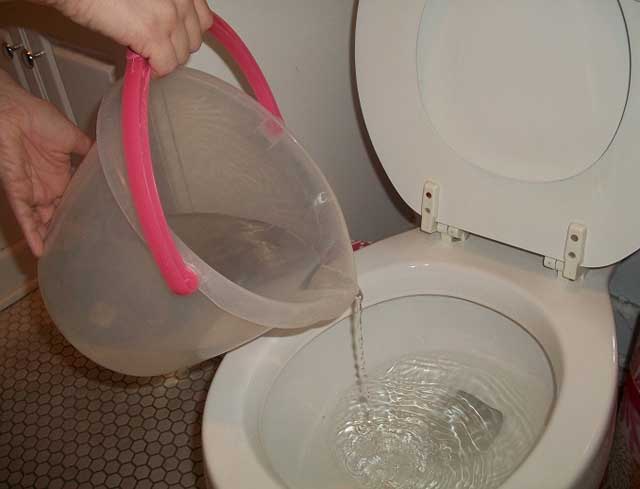 These simple manipulations allow you to eliminate a slight blockage in the sewer system.
These simple manipulations allow you to eliminate a slight blockage in the sewer system.
Another method of how to clean the toilet without a plunger and a cable is based on the use of soda:
- Half a pack of soda is poured into the plumbing fixture.
- Wait a few minutes and drain the water.
Since soda is an active alkali, it has the ability to dissolve loose plugs and thereby restore the functioning of plumbing.
The next method, than to break through a blockage in the toilet, involves the use of boiling water, soda and vinegar:
- Water is scooped out of the device, leaving a small amount of it at the drain point.
- Pour half a pack of soda, trying to get it as deep as possible.
- A glass of 9% vinegar is added to the drain.
- After 20 minutes, a kettle of boiling water is poured into the device or water is drained into it.
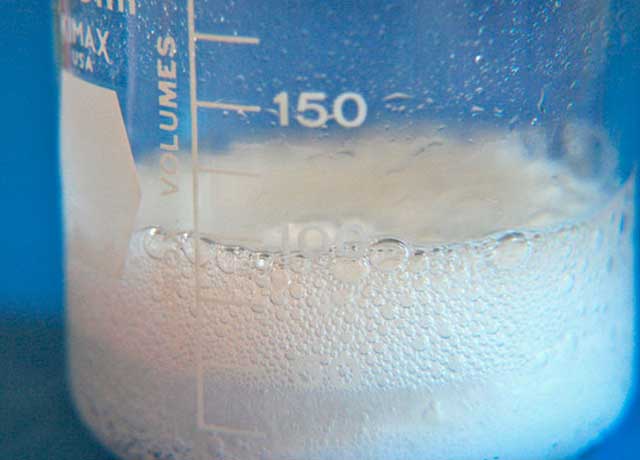 When deciding what to do about a blockage in the toilet, experts do not advise using boiling water when the plumbing is equipped with a thin connecting plastic corrugation. If you need to use a flush, it is better to use hot water. See also: "The toilet is clogged - what to do, how to clean it if it is clogged, options for eliminating blockages."
When deciding what to do about a blockage in the toilet, experts do not advise using boiling water when the plumbing is equipped with a thin connecting plastic corrugation. If you need to use a flush, it is better to use hot water. See also: "The toilet is clogged - what to do, how to clean it if it is clogged, options for eliminating blockages."
Often, property owners are interested in: if the toilet is clogged, how to clean it yourself without a plunger.
The method lies in the fact that mustard is used, which is always available in every home:
- Pour 10 liters of water into a bucket.
- Dissolve 5 teaspoons of mustard in hot water at the rate that 1 spoon is used for 2 liters of water.
- The resulting solution is poured into the toilet and after 5 minutes the water is flushed.
- If necessary, this composition can be used several times.
The first way to get rid of blockage is boiling water. However, this method and all others that use boiling water can be used if the toilet is connected to the riser with a plastic or metal pipe. If a corrugated pipe made of thin plastic is used to connect the toilet, then hot water should be used instead of boiling water.
- For cleaning, you will need a bucket of boiling water. It must be poured as quickly as possible not onto the walls of the toilet bowl, but into its hole, so that boiling water immediately enters the knee canal.
- After pouring water, you must wait 30 ÷ 35 minutes.
With a recent blockage of the toilet bowl, a bucket of boiling water often helps to cope. But this method is not always acceptable!
- If the boiling water worked, and the water began to leave, then after leaving it, the procedure must be repeated. And so - until the normal function of the toilet bowl is restored.
The second cleaning option is the use of soda. Washing soda ash is better suited for punching the gap, but food grade is also possible. Some experienced housewives recommend adding regular salt as well - about half as much soda.
Washing soda ash is suitable for cleaning toilets and sewer pipes.
- A pack of soda (500 grams) is taken and poured into the toilet.
- Then the toilet is filled with a liter of boiling water.After that, a reaction will begin inside the knee, which can also clear it of blockage. Soda is an active alkali that can dissolve many substances, so it is often used not only for cleaning plumbing, but also for kitchen accessories.
The third cleaning method also includes soda ash, but in addition to it, vinegar and boiling water are used in this case.
- One and a half packs of soda (that is, 750 grams) is poured into the drain area.
- A glass or 0.5 liters of 9% vinegar is poured into it. When the vinegar is poured in, a reaction should begin, accompanied by hissing and foaming. This mixture must be left for 20÷25 minutes.
- After waiting for this time, 2 ÷ 3 liters of boiling water are poured into the toilet, and again left for 15 ÷ 20 minutes. After that, you can try flushing with plain water.
In this case, mustard powder and hot water are used to clean the toilet (one small spoonful of mustard powder is taken for two liters of water), and the composition is made as follows:
- In a metal bucket or pan, 6÷8 liters of water are heated.
- Then 3 ÷ 4 tablespoons of mustard are poured into it and mixed.
- The solution is poured into the toilet and left for 15-20 minutes.
- After that, it is necessary to drain the water from the tank or from the collected bucket.
If necessary, the process must be repeated several more times.
What is the best way to use?
What to do in case of a clogged toilet: use a mechanical cleaning method or use chemical preparations to clog the toilet? The answer to this question depends on whether the water drains poorly or does not drain at all.If a foreign object gets into the toilet, then we clean it with a conventional plunger or you can push it further into a wide sewer pipe with a cable.
In the case of the formation of a cork from fat, hair or deposits on the walls of the pipe, it will be most effective to eliminate it with the help of chemical reagents. You can also combine cleaning with chemicals and a cable - then as a result you can also get clean drain walls, for which it will not be possible for small debris to catch on.
There are such pollution against which all of the above methods are useless. For example, if during repairs various remnants of putty and plaster solutions were washed into the toilet, then no chemical agent can cope.Theoretically, there is such a tool, but in practice it will corrode the cork just as easily as the pipes themselves.
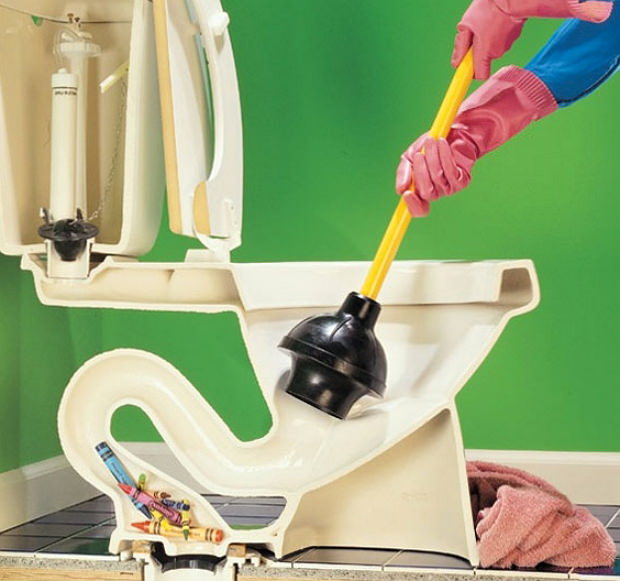
Sewer cleaning chemicals
Today, on the shelves of trade enterprises, a diverse range of chemicals is presented for cleaning the toilet bowl from clogging and the entire structure of the drainage system.
The following products are especially popular with consumers:
- Tiret gel;
- Flup granules;
- Mister Muscle;
- mole powder;
- Bagi Pothan.
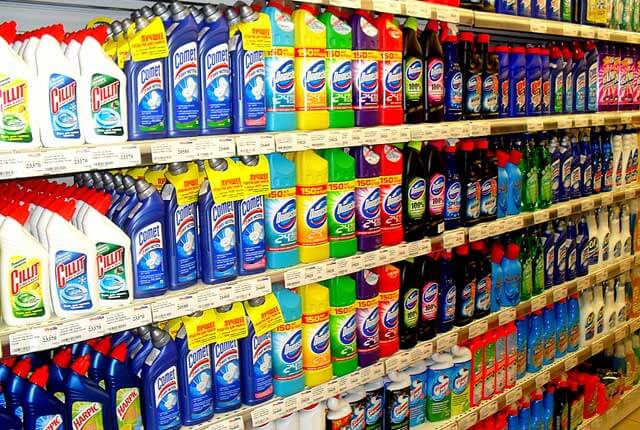 Before using a chemical toilet cleaner, be sure to carefully read the manufacturer's instructions for this product. In the process of its application, it is necessary to remember the security measures. Many household chemicals contain aggressive components that, after contact with the skin and mucous membranes, can cause serious harm to health.
Before using a chemical toilet cleaner, be sure to carefully read the manufacturer's instructions for this product. In the process of its application, it is necessary to remember the security measures. Many household chemicals contain aggressive components that, after contact with the skin and mucous membranes, can cause serious harm to health.
When handling a clogged toilet bowl, use rubber gloves and ventilate the toilet or kitchen area.See also: "The toilet is clogged - how to clean it at home, which tool is better to use."
To use it, you need to perform a number of actions:
- Pour into the toilet the dose of the drug recommended in the instructions for the product.
- Wait a certain amount of time.
- Rinse off with a strong stream of water.
Strong compounds can harm metal and plastic pipes. In order not to provoke an unexpected chemical reaction, you can not use several drugs at the same time.
Chemicals
People who do not want to clear blockages mechanically use chemical products.
Liquid
To clean plastic drain pipes, chemical compounds produced in liquid form are used. They are characterized by a soft action that does not damage the surface of the plastic. The most effective liquid products include "Mr. Muscle" with a slight ammonia smell and "Tiret", which does not smell of anything.
Powders
Chemical formulations are also available in powder form to help clear blockages.
Effective powdered detergents include "Komet".This is a universal powder that is used not only for cleaning sewers, but also for washing household appliances. To get rid of blockage, "Komet" is poured into the drain and poured with hot water.
Acidic
Acid agents will help to remove serious blockages, due to which the liquid has completely stopped draining. They are able to eliminate food residues, as well as traces of grease and dirt on the pipes.
alkaline
Alkaline products are ideal for cleaning sinks installed in the kitchen. They effectively fight grease residues that can remain in the drain after washing dirty dishes or pans.
When choosing alkaline products, you need to pay attention to "Domestos" and "Whiteness"
Rules for the use of household chemicals
The use of chemicals requires compliance with certain rules:
- to avoid the appearance of allergies and burns on the skin, put on household gloves before work;
- before choosing a method and means of cleaning the toilet bowl and pipes, the material from which they are made should be taken into account;
- do not increase the dosage of the concentrate used.
If you follow all the recommendations specified in the instructions, it will be possible to carry out all the actions correctly.
Mechanical ways to eliminate blockages
If you want to eliminate the blockage in the sewer system after foreign objects get into it, a good result in solving the problem of how to clean the toilet can be provided by mechanical methods carried out:
- using a plunger;
- with the help of the so-called "doll";
- using a cable;
- with film.
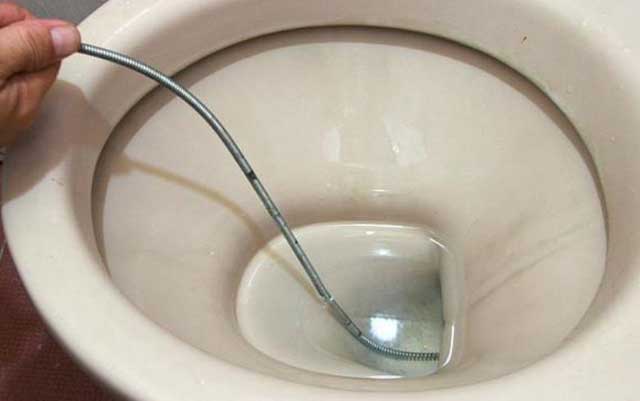 Their main advantage is ease of implementation.
Their main advantage is ease of implementation.
Cleaning with a plunger is used in case of slight blockage. The device should have a cone-shaped nozzle with a diameter of 10 centimeters.
The work is done like this:
- The toilet is filled with water.
- The plunger is placed in the drain hole and, holding it by the handle, make several clicks.
- With a sharp movement, the device is removed from the drain hole.This procedure can be repeated several times.
If there is no such product in the house, you can use a standard plastic bottle with a cut off bottom - it is used in the same way as a plunger.
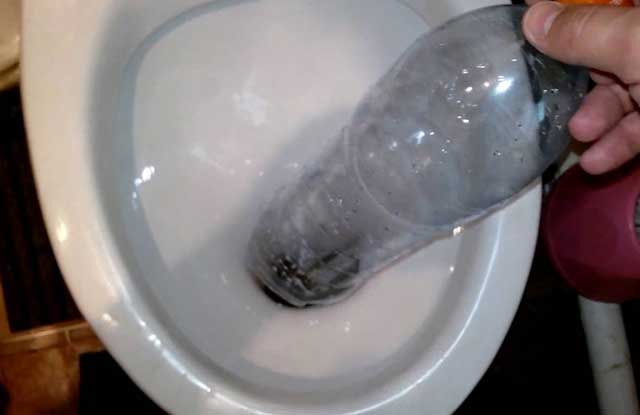 The use of the so-called "doll" is another way to clean the toilet. A homemade object is made from a fabric bag, which is filled with sand and supplied with a long rope.
The use of the so-called "doll" is another way to clean the toilet. A homemade object is made from a fabric bag, which is filled with sand and supplied with a long rope.
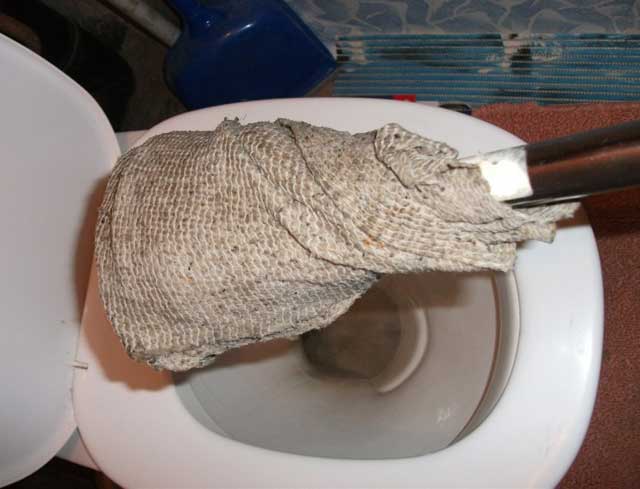 "Doll" is used as follows:
"Doll" is used as follows:
- She is placed in the plumbing drain hole, holding the rope in her hands.
- They press the drain and wait for the water flow to carry the bag along with it.
- Then it is removed from the toilet using a rope.
- Due to its weight, the sandbag eliminates the blockage formed in the water seal.
There is a way to clean the toilet with a cable at home. This flexible sanitary ware is distinguished by the presence of a hollow rigid axis and a handle. The handle allows the rope to rotate. At the end of the axis there is a spiral process, which is attached to the cable with a flexible tube.
If you need to implement a method on how to clean the toilet with a cable, do this:
- Lower the end of the tool into the drain hole of the device until it stops.
- Performing rotational movements with the handle of the device, slowly push the cable into the water seal.
- When the process of eliminating the blockage is eliminated, the drain system is washed with hot water.
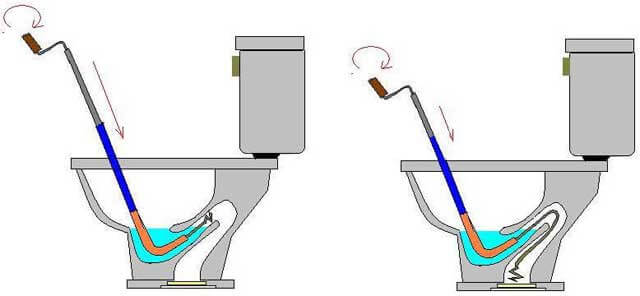 Before you clean the toilet with a cable, it is important to choose the right length and diameter when buying it. These actions can be carried out, including with the help of a conventional product purchased at a hardware store.
Before you clean the toilet with a cable, it is important to choose the right length and diameter when buying it. These actions can be carried out, including with the help of a conventional product purchased at a hardware store.
You can also use another method than to eliminate the blockage in the toilet, which consists in the use of a film. To remove objects that have fallen into it from the plumbing device, in this case, you will need a wide adhesive tape.
When using it, proceed as follows:
- Wipe the toilet seat dry.
- Tape strips are glued to the circle, connecting them together so tightly that a continuous film coating is formed.
- When the device is completely hermetically sealed, drain the water in it.
- After performing a few strong hand pressures on the cover created from adhesive tape, the resulting blockage will be broken.
- After completion of work, the film is removed from the seat.
plunger
This simple but effective device is used by many housewives in the kitchen to clean the drain hole of the sink. It is also indispensable in the toilet when removing blockages located shallow. A plumbing plunger consists of a cup-shaped rubber suction cup, worn on an elongated, usually wooden handle. Under the influence of hydraulic pressure created by water and air when pumping the tip of the plunger, most of the contaminants are destroyed and pushed forward.
When using a plunger, the following actions are performed:
- water is poured into the toilet bowl;
- bring the suction cup of the plunger to the drain hole, closing it as tightly as possible;
- make 5-10 pumps, sharply pressing the plunger handle;
- after pumping, the suction cup is peeled off.
Sometimes it is not possible to eliminate the blockage with a plunger immediately, but after several attempts.
Important! To create sufficient hydraulic pressure, the tip of the plunger should be slightly larger than the drain hole.
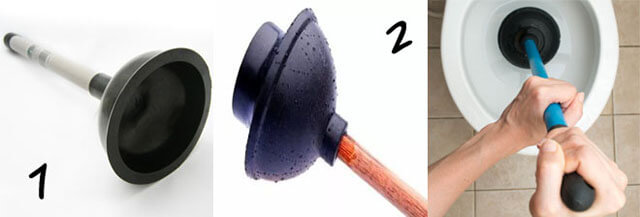 Advantages and disadvantages of cleaning the toilet with a cable
Advantages and disadvantages of cleaning the toilet with a cable
One of the main advantages of a toilet tether is that it is easy to use. It is enough just to lower the device into the drain hole and rotate it. Works can be carried out at great depths of pipes, up to 70 m. Thanks to special nozzles on the tip, the blockage is easy to clean. It is pushable and breaks down quickly. Another positive feature of the device is its flexibility, the blockage can be cleared in pipes of different configurations.
Of the shortcomings, plumbers and homeowners note only 3 points:
- Careless handling can damage the plastic walls of the pipes.
- The process of breaking through the garbage plug can take a long time (10-40 minutes). The blockage is not always possible to clean out the first time.
- After work, the device must be washed from dirt residues.
Comment! The dried tool must be lubricated with machine oil. This will extend its lifespan.
What remedies won't help?
There are many tips on how to clear a blockage in the toilet, but not all of them are effective.
- Fairy is a popular dishwashing product that handles grease easily, but such a cork is a rarity in the toilet.
- Whiteness - compounds with chlorine disinfect the surface, dissolve light limescale and other deposits. They are recommended as a prevention of drain clogging, but will not cope with the problem.
- Coca-Cola or Pepsi-Cola - drinks are advised to use for cleaning plumbing. They can remove rust stains or alkaline deposits, but not cork.
Using inefficient methods is a waste of money and time.
When should you call a plumber?
There are cases when it is clearly impossible to manage on your own, and you will have to call a plumber. For example, if water rises in the toilet by itself, this clearly indicates that the neighbors below have a strong blockage.
The most dangerous situation is when the water rises along with the waste. In high-rise buildings, residents of the lower floors are most exposed to this risk. In such a situation, it is worth calling the emergency service.
Also, you can’t do without the help of professionals if all the efforts made to clear blockages on your own did not bring results, and the water continues to leave very badly.
Recommendations
Recommendations of plumbers will help to cope with the task of cleaning efficiently and without unpleasant consequences:
- Finding that the toilet is clogged, you should not try to immediately drain the water from the tank. It should be borne in mind that the volume of water in it is several liters.If it merges into a bowl, then part of it may even splash onto the floor.
- If an object has fallen into the toilet by accident, such as a toy, keys, etc., then do not press the flush, as this may result in a blockage. In this case, it is necessary to put on rubber gloves and get the thing.
- All pipe cleaning work should be done with rubber gloves, even when folk remedies are used to eliminate blockages.
- It is more convenient to break through a blockage with a cable together, when one person rotates with a handle, and the other directs the cable itself to the place of the plug.
Prevention - what to keep your sewers from clogging
The main methods of preventing blockages in the toilet:
- If it is necessary to replace the pipeline, it is desirable to select products that are exactly the right size.
- If the owner of the house does not have the appropriate construction experience, it is better to entrust the installation of the toilet bowl and its connection to the sewer to a professional. This will prevent incorrect system design and installation errors that will cause frequent blockages in the toilet.
- If the bathroom is being renovated, the toilet lid must be constantly lowered. Otherwise, construction debris and other solid waste will get inside.
- Adhere to the operating rules: do not wash off thick paper, grease, food particles, sand and other objects that can lead to blockage in the sewer.
- Regularly clean the pipeline using special chemicals.
- Every week it is recommended as a preventive measure to clean the sewer with boiling water or a plunger.
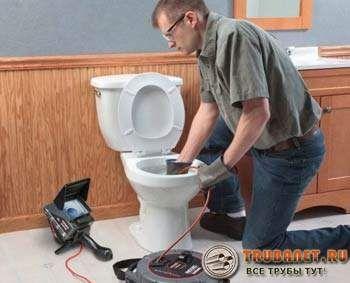 These simple rules will help you avoid the need to replace plumbing fixtures and then not think about what to do if the toilet is clogged due to the ingress of foreign objects - such as children's toys or rags. A blockage in the toilet bowl can be eliminated with your own hands, but in difficult situations it is better to entrust this procedure to professionals with the necessary equipment.
These simple rules will help you avoid the need to replace plumbing fixtures and then not think about what to do if the toilet is clogged due to the ingress of foreign objects - such as children's toys or rags. A blockage in the toilet bowl can be eliminated with your own hands, but in difficult situations it is better to entrust this procedure to professionals with the necessary equipment.
Thus, it is possible to cope with blockages in the toilet with the help of various means. You can use both folk methods and chemical means or mechanical methods. Which option to eliminate the plug to choose depends primarily on the cause of the blockage.
Based on this information, you can begin to get rid of the blockage. It is also not recommended to forget about prevention. Periodic cleaning will help prevent clogging and other sewer problems.
